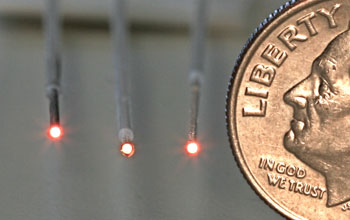Multimedia Gallery
New Sensors for First Responders
Porous photonic crystal microsensor particles on the ends of optical fibers can detect organic pollutants.
These carbon nanostructures were created by researchers at the University of California, San Diego, led by Michael Sailor, a professor of chemistry and biochemistry and bioengineering, and Tyco Electronics. Sailor's research group successfully embedded these fibers into activated charcoal canisters used for respirators. For emergency workers who wear respirators to avoid inhaling toxic fumes, these sensors could be used to alert them when the carbon filters in their respirators have become dangerously saturated.
Sailor says "The new sensors would provide a more accurate reading of how much material the carbon in the filters has actually absorbed. Because these carbon nanofibers have the same chemical properties as the activated charcoal used in respirators, they have a similar ability to absorb organic pollutants."
This research was funded in part by a grant from the National Science Foundation (DMR 08-06859). To learn more, see the UC-San Diego news release New Material Could Improve Safety for First Responders to Chemical Hazards. (Date of Image: January 2009)
Credit: Brian H. King and Michael J. Sailor, University of California, San Diego
See other images like this on your iPhone or iPad download NSF Science Zone on the Apple App Store.
Images and other media in the National Science Foundation Multimedia Gallery are available for use in print and electronic material by NSF employees, members of the media, university staff, teachers and the general public. All media in the gallery are intended for personal, educational and nonprofit/non-commercial use only.
Images credited to the National Science Foundation, a federal agency, are in the public domain. The images were created by employees of the United States Government as part of their official duties or prepared by contractors as "works for hire" for NSF. You may freely use NSF-credited images and, at your discretion, credit NSF with a "Courtesy: National Science Foundation" notation.
Additional information about general usage can be found in Conditions.
Also Available:
Download the high-resolution JPG version of the image. (645 KB)
Use your mouse to right-click (Mac users may need to Ctrl-click) the link above and choose the option that will save the file or target to your computer.

